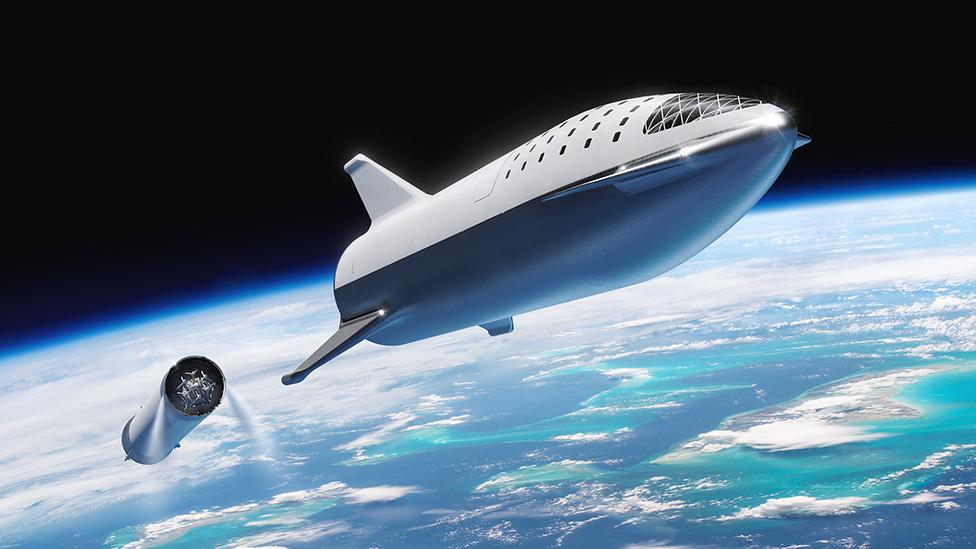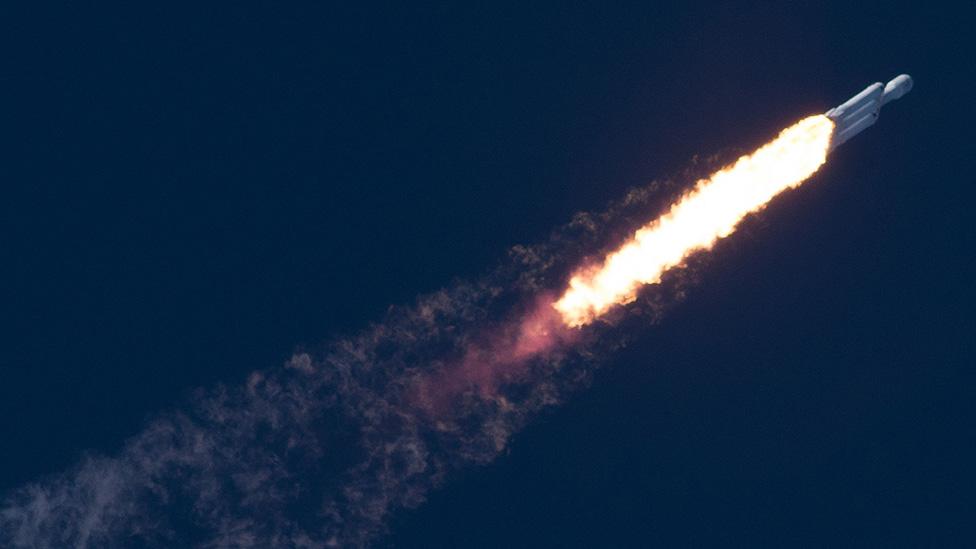'Starhopper': SpaceX engine testbed makes minute-long jump
- Published
Watch Starhopper fly (Credits: Photo by Reuters/Trevor Mahlmann; Video by SpaceX)
The American rocket company SpaceX conducted a successful flight of its "Starhopper" testbed on Tuesday.
The vehicle lifted 150m into the air, moved sideways and then gently put itself back down onto the ground.
Starhopper is part of an effort to develop a new engine that will burn liquid methane in contrast to the kerosene in the firm's current engines.
This motor, known as the Raptor, will power SpaceX's next-generation Starship and Superheavy rockets.
Tuesday's one-minute test, which took place at Boca Chica in Texas, was the second hop for the vehicle after a modest 18m jump in July.
Federal Aviation Administration (FAA) licensing had previously limited activity to no more than 25m above the ground.
Allow X content?
This article contains content provided by X. We ask for your permission before anything is loaded, as they may be using cookies and other technologies. You may want to read X’s cookie policy, external and privacy policy, external before accepting. To view this content choose ‘accept and continue’.

Police in the area had asked local residents to come out of their homes during the flight as a safety precaution, just in case the Raptor's firing produced a pressure wave capable of breaking windows.
SpaceX is expected now to turn Starhopper into a static engine test stand, shifting flight action instead to two Starship prototypes.
One of these is being built in Boca Chica; the other is under construction in Cocoa, Florida.
These vehicles will feature at least three Raptors to lift themselves up and put themselves down. The capability should see them reach very high altitudes. Initial flights ought to start before the end of the year.
The knowledge gained will be incorporated into the operational Starships and their Superheavy boosters when they debut, which will be no earlier than 2021 according to the company.

Artist's impression: The Starship would take on multiple roles for SpaceX
These fully reusable vehicles will be huge, standing nearly 120m tall when stacked one on top of the other. That would make the combined unit taller than the Saturn V Moon rockets.
Published designs have been somewhat fluid in recent years, but the Superheavy could have 35 Raptors firing in parallel when it lifts off. The Starship will probably use six.
SpaceX presently operates its much smaller Falcon rocket series, but Starship/Superheavy, the company says, will eventually take over all missions.
The California-based firm is proposing versions of the new vehicles that will be able to put satellites in orbit, and to send cargo, fuel and people beyond Earth, to destinations such as the Moon and Mars.
Company CEO Elon Musk even talks of point-to-point travel, using the Starship to take passengers from one continent to another in rapid time.

The company's existing rockets burn kerosene in their Merlin engines
The Raptor engine is an integral part of the plan. Liquid methane burns cleaner than kerosene and is easier to handle than liquid hydrogen - the other two major rocket fuels predominantly in use today.
SpaceX is not the only company moving over to methane. Competitor Blue Origin, owned by Amazon entrepreneur Jeff Bezos, will use the fuel in its BE-4 engine, which will power its forthcoming New Glenn rocket.
In Europe, engineers are also working on a liquid-methane powered engine called Prometheus, which could eventually be deployed on future Ariane rockets.